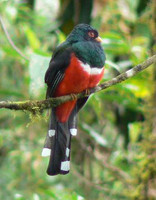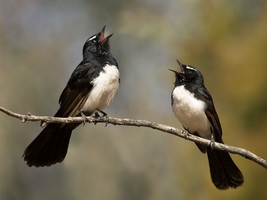'Land Birds'
John Harshman


This tree diagram shows the relationships between several groups of organisms.
The root of the current tree connects the organisms featured in this tree to their containing group and the rest of the Tree of Life. The basal branching point in the tree represents the ancestor of the other groups in the tree. This ancestor diversified over time into several descendent subgroups, which are represented as internal nodes and terminal taxa to the right.

You can click on the root to travel down the Tree of Life all the way to the root of all Life, and you can click on the names of descendent subgroups to travel up the Tree of Life all the way to individual species.
For more information on ToL tree formatting, please see Interpreting the Tree or Classification. To learn more about phylogenetic trees, please visit our Phylogenetic Biology pages.
close boxSummary phylogenetic hypothesis for avian orders based on Hackett et al. (2008) and Ericson et al. (2006).
Discussion of Phylogenetic Relationships
"Land Birds" is an informal name for a large and diverse group supported only by molecular characters (Hackett et al. 2008, Ericson et al. 2006). It encompasses most — though by no means all — of the familiar groups of land birds, including the largest order, Passeriformes, which comprises over half of all bird species. This group and relationships within it are a considerable departure from previous phylogenetic hypotheses and classifications, and some explanation is necessary.
Two traditional orders, Falconiformes and Coraciiformes, have been split. The family Falconidae (falcons) is not a close relative of the remaining falconiforms, and thus Falconiformes is limited to a single family (the falcons). The remaining birds of prey traditionally included within Falconiformes have been given their own order, Accipitriformes. Accipitriformes includes Cathartidae (New World vultures), which have often been supposed to be more closely related to Ciconiidae (storks).
Coraciiformes as traditionally defined includes both Bucerotiformes and Leptosomatidae. But if these groups were retained in the order, two additional orders, Piciformes and Trogoniformes, would also have to be submerged within it to maintain monophyly.
"Land Birds" holds other surprises. There has long been controversy about which group should be considered the closest relatives of Passeriformes. Traditional candidates have included Coraciiformes, Piciformes, Coliiformes, and Columbiformes (doves, which do not in fact belong to "Land Birds"). Psittaciformes and Falconiformes had not previously been suggested, and while further confirmation is needed, current molecular data show strong support for this grouping. Cariamidae (seriemas), traditionally considered to belong to Gruiformes, may also be closer to Passeriformes than to most other "Land Birds", though the support for this is not strong.
References
Ericson, P. G. P., C. L. Anderson, T. Britton, A. Elzanowski, U. S. Johansson, M. Kallersjo, J. I. Ohlson, T. J. Parsons, D. Zuccon, G. Mayr. 2006. Diversification of Neoaves: integration of molecular sequence data and fossils. Biology Letters 2(4):543-547.
Hackett, S. J., Kimball, R. T., Reddy, S., Bowie, R. C. K., Braun, E. L., Braun, M. J., Chojnowski, J. L., Cox, W. A., Han, K.-L., Harshman, J., Huddleston, C. J., Marks, B. D., Miglia, K. J., Moore, W. A., Sheldon, F. H., Steadman, D. W., Witt, C. C., and Yuri, T. 2008. A phylogenomic study of birds reveals their evolutionary history. Science 320(5884):1763-1768.
Title Illustrations

| Scientific Name | Trogon personatus |
|---|---|
| Location | Bellavista Cloud Forest Reserve, Tandayapa Valley, Ecuador |
| Specimen Condition | Live Specimen |
| Source | Masked Trogon at Bellavista Cloud Forest |
| Source Collection | Flickr |
| Image Use |
 This media file is licensed under the Creative Commons Attribution-NonCommercial-ShareAlike License - Version 2.0. This media file is licensed under the Creative Commons Attribution-NonCommercial-ShareAlike License - Version 2.0.
|
| Copyright | © 2006 RK & Tina |
| Scientific Name | Rhipidura leucophrys |
|---|---|
| Location | Campbell park, Canberra, Australian Capital Territory, Australia |
| Specimen Condition | Live Specimen |
| Source | Joyful innocent tuneful happiness... |
| Source Collection | Flickr |
| Image Use |
 This media file is licensed under the Creative Commons Attribution-NonCommercial License - Version 2.0. This media file is licensed under the Creative Commons Attribution-NonCommercial License - Version 2.0.
|
| Copyright | © 2006 Julian Robinson |
| Scientific Name | Trigonoceps occipitalis |
|---|---|
| Location | between Satara and Lethaba, Kruger National Park, South Africa |
| Specimen Condition | Live Specimen |
| Source | This is a tiring exercise 10/12 |
| Source Collection | Flickr |
| Copyright |
© 2006 Callie de Wet

|
About This Page
Correspondence regarding this page should be directed to John Harshman at
Page copyright © 2008
 Page: Tree of Life
'Land Birds'.
Authored by
John Harshman.
The TEXT of this page is licensed under the
Creative Commons Attribution-NonCommercial License - Version 3.0. Note that images and other media
featured on this page are each governed by their own license, and they may or may not be available
for reuse. Click on an image or a media link to access the media data window, which provides the
relevant licensing information. For the general terms and conditions of ToL material reuse and
redistribution, please see the Tree of Life Copyright
Policies.
Page: Tree of Life
'Land Birds'.
Authored by
John Harshman.
The TEXT of this page is licensed under the
Creative Commons Attribution-NonCommercial License - Version 3.0. Note that images and other media
featured on this page are each governed by their own license, and they may or may not be available
for reuse. Click on an image or a media link to access the media data window, which provides the
relevant licensing information. For the general terms and conditions of ToL material reuse and
redistribution, please see the Tree of Life Copyright
Policies.
- First online 27 June 2008
- Content changed 27 June 2008
Citing this page:
Harshman, John. 2008. 'Land Birds'. Version 27 June 2008 (under construction). http://tolweb.org/%27Land_Birds%27/26410/2008.06.27 in The Tree of Life Web Project, http://tolweb.org/











 Go to quick links
Go to quick search
Go to navigation for this section of the ToL site
Go to detailed links for the ToL site
Go to quick links
Go to quick search
Go to navigation for this section of the ToL site
Go to detailed links for the ToL site